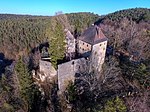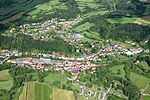Rabenstein Castle (Upper Franconia)
Bayreuth (district)Castles in BavariaFalconryFranconian SwitzerlandHeritage sites in Bavaria ... and 1 more
Hill castles

Rabenstein Castle (German: Burg Rabenstein) is a former high medieval aristocratic castle in the municipality of Ahorntal in the Upper Franconian county of Bayreuth in the German state of Bavaria. The spur castle may be visited for an entrance fee.
Excerpt from the Wikipedia article Rabenstein Castle (Upper Franconia) (License: CC BY-SA 3.0, Authors, Images).Rabenstein Castle (Upper Franconia)
Rabenstein, Ahorntal
Geographical coordinates (GPS) Address Website External links Nearby Places Show on map
Geographical coordinates (GPS)
| Latitude | Longitude |
|---|---|
| N 49.8221528 ° | E 11.3707361 ° |
Address
Burg Rabenstein
Rabenstein
95491 Ahorntal
Bavaria, Germany
Open on Google Maps







